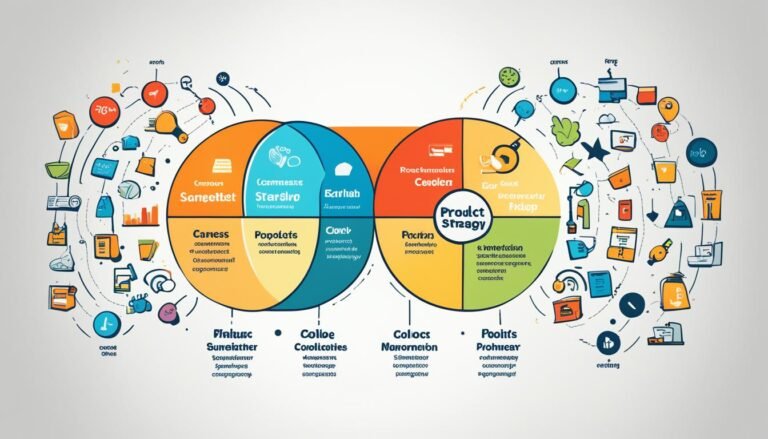The 4 Ps of Marketing: Product, Price, Place, Promotion
Did you know the 4 Ps of marketing can change your business for the better? Studies show that spending on promotions, like Nike’s “Just Do It” campaign, can really help sales and your position in the market. The 4 Ps—Product, Price, Place, and Promotion—are key to a strong marketing strategy. They are essential for success in many industries.
Marketing expert E. Jerome McCarthy first thought of the 4 Ps. Neil Borden made them popular in the 1950s. These elements guide your branding and how you stand out in the market. Even with new additions like People, Process, and Physical Evidence, the core 4 Ps are still crucial. They help you deal with market changes and meet what customers want.
Key Takeaways
- The 4 Ps of marketing—Product, Price, Place, and Promotion—are crucial for creating a successful marketing strategy.
- Understanding the product life cycle is essential for financial planning, resource allocation, and risk assessment.
- Value-based pricing strategies have led to high-profit margins for companies like Apple.
- Direct-to-consumer models can increase profit margins by eliminating intermediaries.
- Investment in promotional activities can substantially boost sales and market share.
Introduction to the 4 Ps of Marketing
The 4 Ps of Marketing—Product, Price, Place, and Promotion—form the core of a winning marketing strategy. They help businesses create plans that match what customers want and adjust to market changes.
These ideas started in the mid-1900s and are still key today. Companies must carefully look at their product offerings, set the right prices, place their products well, and use promotions to grab their audience’s attention.
Apple, a giant in tech, sold $205.4 billion worth of iPhones in FY 2022. This shows how well they use the 4 Ps. They focus on making new products, set high prices, place their products smartly, and promote them well to keep customers loyal.
e.l.f. Cosmetics is another example of success with a unique marketing mix. They sell affordable makeup in places like drugstores and big-box retailers. They use social media, like TikTok and Instagram, to connect with young customers.
The BMW Z3, featured in the 1995 movie GoldenEye, got 9,000 orders right after it came out. This shows how smart promotion can make a big difference in the marketing mix.
Marketing Hub also shows how pricing can vary based on what customers need and want. They offer plans from $0/month to $3,200/month. Their focus on direct sign-ups on their website shows how important digital channels are today.
These examples show how the 4 Ps help businesses achieve their goals and make customers happy. They create a complete plan for success in the market.
Understanding the Concept of Product in Marketing
The idea of product in marketing is key and always changing. It’s about making products that stand out and meet customer needs. Products can be anything from basic tools to unique designs.
Defining the Product
A product is more than just what you can see. It’s about how it makes people feel, its quality, and what it offers. Apple is great at making products that are both new and focused on the user. The iPhone, for example, changed the smartphone world with its innovation and focus on users.
Product Life Cycle
Knowing about the product life cycle is key for marketing success. It has four stages: introduction, growth, maturity, and decline. Each stage has its own challenges and chances to grow. It’s important for companies to adjust their plans as they move through these stages.
Example of Successful Products
Looking at successful products can teach us a lot. The iPhone changed mobile technology with its constant updates and great design. Its success comes from always improving, knowing what customers want, and being different. This shows how important it is for companies to think about both what a product does and how it makes people feel to win over customers.
The Role of Price in the Marketing Mix
When talking about the marketing mix, price plays a big role. A good pricing strategy can make a product hit or miss. The price should match the product’s value, making customers feel they’re getting a good deal.
Using competitive pricing can help your brand stand out. For example, UNIQLO sells quality, affordable clothes. They do this by managing costs and partnering globally to keep prices low.
Getting the pricing right means balancing costs, demand, and what competitors charge. High prices can make a product seem luxurious. On the other hand, lower prices attract those watching their wallets. The key is to make a value proposition that speaks to your audience.
A strong value proposition changes how people see your brand. Some brands charge more to show they offer top quality and exclusivity. Others offer lower prices to be seen as affordable and welcoming.
In today’s fast-changing market, new pricing strategies are key. Things like dynamic pricing, discounts, and flexible payment options can boost sales and change how people act. Studies show a clear pricing strategy affects buying choices and sales, showing its big role in marketing.
By working on a strong pricing strategy, companies can meet market needs and stand out. This approach builds long-term loyalty and helps businesses grow.
Place: Distribution Channels and Market Placement
“Place” is key in marketing, showing how products get to consumers. Distribution strategies are vital for putting products in the right spots, online and offline. This helps make sure products are easy to find.
Choosing the best channels and partners is part of distribution strategies. This might mean using both physical stores and online platforms. Moving products online has greatly expanded their reach. Studies show that updating physical stores to improve the shopping experience led to more people coming in and buying more.
Getting products in the right retail spots is also crucial. For example, BMW placed its Z3 model in the James Bond film “GoldenEye”. This move boosted its visibility and led to a lot of pre-orders. It shows how smart placement can make a brand more popular and interesting to customers.
Companies with happy employees tend to have happier customers, which helps with retail positioning. Using an omnichannel strategy can also lead to higher profits and keeping customers coming back. In fact, 62% of firms focused on customers saw their profits go up.
The goal is to create a strong, smooth, and adaptable distribution network. It should match what consumers like, ensuring easy access and good retail spots.
Promotion Strategies to Boost Awareness and Sales
Promotion strategies are key to telling people about products. They help get the product in front of the right people. This includes using ads, social media, and PR. These methods change with what people like and help start successful marketing efforts.
Advertising Campaigns
Advertising campaigns aim to promote products or services through different media. They help make brands more known and increase sales. For example, Absolut Vodka’s ads ran for over 20 years. They made the brand well-known with creative messages on many platforms.
Using Social Media for Promotion
Social media has changed how brands talk to their audience. Sites like Facebook, Instagram, and Twitter let businesses talk directly to customers. This builds a loyal customer base and spreads the word about the brand. With smart digital marketing, companies can target specific groups of people based on their interests and behaviors.
Public Relations and Media Strategy
Public relations (PR) and media strategies are key to promoting brands well. A good PR plan manages how the public sees a brand through events, press releases, and media talks. Companies like Apple and Nike use PR to create excitement and keep a good public image. Their media strategies help keep people positive about them, which boosts sales and their market standing.
History and Evolution of the 4 Ps of Marketing
The story of the 4 Ps of marketing is fascinating. It shows how marketing has changed over the years. It started in 1949 with Neil Borden’s idea of the “marketing mix.” He said it was a blend of ingredients needed for successful marketing.
In 1960, E. Jerome McCarthy made the marketing mix more specific. He added Product, Price, Place, and Promotion as the main parts. These became key for making strong marketing plans.
“The marketing mix is a set of controllable, tactical marketing tools that work together to achieve a company’s objectives,” McCarthy explained. These elements need to be managed and balanced to effectively market products and services.
Albert Frey added more depth in 1961. He divided marketing into two main parts: offering and process. This showed how important a full marketing strategy is.
Then, in 1981, Bernard Booms and Mary Bitner added People and Process to the mix. They showed how important people and service experiences are. This made marketing strategies more complete.
E-commerce changed the “place” part of marketing. Companies like Walmart and Amazon show how important good processes and logistics are. Steve Jobs also showed the value of hiring talented people for their ideas.
Promotional tactics have also changed. Now, social media like Instagram and Facebook are key for promoting brands. Tools like Micro TSP help with statistical analysis in marketing.
The 4 Ps of marketing have changed to keep up with the digital world. They help businesses meet consumer needs and stay ahead. Whether it’s the original four or the seven P’s, the marketing mix is still crucial.
Examples of the 4 Ps of Marketing: Product, Price, Place, Promotion
Let’s look at some real-world applications of the 4 Ps of marketing. We’ll see how companies like Apple use strategic product positioning and marketing for growth and a competitive edge. By studying case studies from well-known companies, we learn how these strategies work.
Apple is a great example. In FY 2022, they sold $205.4 billion worth of iPhones. This shows how Apple keeps innovating to meet what customers want. By 2021, they sold 2 billion iPhones worldwide, proving their strong product positioning strategy.
UNIQLO is another success story. They focus on high-quality, innovative products and work directly with manufacturers to cut costs. This strategy helps UNIQLO stay competitive in the global market.
The automotive industry also offers great case studies. BMW saw a huge spike in orders after featuring the Z3 car in the 1995 James Bond movie GoldenEye. This shows how strategic promotion and product placement can boost sales.
Absolut Vodka’s ad campaign from 1981 to 2005 is another example of effective promotion. Their ads helped increase sales from 10,000 cases in 1980 to 4.5 million by 2000. This campaign is one of the longest-running and most successful in history, proving the power of consistent and unique advertising.
In the restaurant industry, email marketing can increase returning customers by 30%. Adjusting prices based on menu engineering can also boost profits by up to 15%. Highlighting what makes a restaurant special can increase customer engagement by 40%. And keeping your online presence current can lead to a 50% higher click-through rate. These examples show how the 4 Ps can drive success in different real-world applications.
Developing a Marketing Strategy with the 4 Ps
Creating a strong marketing strategy means looking closely at the 4 Ps: Product, Price, Place, and Promotion. Each part of the strategy works together to meet goals and connect with the audience. Let’s see how each P plays a key role in making a full strategy.
Analyzing Your Product
Understanding what your target market needs is key to analyzing your product. Apple’s iPhone sold $205.4 billion in FY 2022, showing the power of matching product features with what people want. This led to selling 2 billion units in 2021.
UNIQLO also succeeded by working with innovative partners and outsourcing production. This ensures their products are top-notch and meet customer needs.
Setting the Right Price
Setting prices right involves looking at costs, what competitors charge, and what customers think is worth it. In restaurants, pricing must balance costs, profit, and competition. Using data helps make pricing decisions that boost revenue and hit marketing targets.
Selecting Distribution Channels
Old-school marketing focused on “place” through physical channels. Now, online and social media play big roles too. BMW got 9,000 Z3 Roadster orders by showing it in the James Bond movie GoldenEye. This shows the value of using various channels to spread the word.
Creating an Effective Promotion Plan
A good promotion plan can really help get your brand noticed and boost sales. Absolut vodka’s ads from 1981 to 2005 show how steady and creative promotions work wonders. Restaurants use social media, emails, and outdoor ads to reach their goals.
Creative deals and ongoing market research can engage customers and increase sales. Word-of-mouth and keeping up with online trends are key in today’s promotions.
When the 4 Ps—Product, Price, Place, and Promotion—are planned well together, marketing can be powerful and hit the mark.
The Relationship Between the 4 Ps and Marketing Objectives
The 4 Ps in marketing—Product, Price, Place, and Promotion—play a key role in reaching marketing goals. Each part is made to match business aims and the needs of a target market, making a strategy that grows the business and stays relevant in the market.
Decisions on the Product, like managing its lifecycle and innovating, are crucial for meeting customer needs and lasting success. For example, Apple’s focus on premium products and innovation has made it a leader in the market. It sold 2 billion iPhones and made $205.4 billion from iPhone sales in 2021.
Using Price smartly means using tactics like cost-plus pricing, competitive pricing, and psychological pricing. Competitive pricing matches your business goals with the target market’s goals, making your prices attractive. UNIQLO’s pricing and sourcing strategy, which involves negotiating with manufacturers and using skilled artisans, shows how to set prices based on market demand.
For Place, having the right distribution channels and market placement is key to reaching your audience well. Apple’s own retail stores improve customer experience and brand strength. BMW’s product placement in the 1995 James Bond movie “GoldenEye” made its Z3 car more visible and desirable, leading to 9,000 orders.
Promotion strategies are vital for making brands known and boosting sales. The famous Absolut vodka ad campaign from 1981 to 2005 shows the impact of consistent and creative promotion. This campaign greatly increased Absolut’s sales, proving how good promotion can meet marketing goals and gain market share.
In conclusion, balancing the 4 Ps helps achieve marketing goals and sets up sustainable business goals that meet your target market’s needs. Understanding how the 4 Ps work together helps businesses stay competitive in a changing market.
Source Links
- Explaining The 4Ps of Marketing (Product, Price, Place, Promotion)
- Marketing Mix: The 4Ps of Marketing and How to Use Them Effectively
- 4 P’s of Marketing: Achieve the Perfect Marketing Mix [2024] • Asana
- The 4 Ps of Marketing: What They Are & How to Use Them Successfully
- What Are the 4 Ps of Marketing? The Marketing Mix Explained [Example]
- The Four Ps of Marketing
- Marketing Mix: The 4 Ps of Marketing and How to Use Them
- The 4 Ps of Marketing: What They Are and How to Use Them
- Marketing strategy | Marketing mix: product, price, place & promotion | Entrepreneur’s Toolkit
- The 4 Ps of Marketing
- Understanding the 4 Ps of Marketing Through Digital Transformation
- The Fundamentals of Marketing: Exploring the 4 Ps of the Marketing Mix
- The 4 Ps of marketing: The core of your marketing strategy | Zapier
- History of Marketing Mix from the 4P’s to the 7P’s
- Council Post: Evolution Of The Four Ps: Revisiting The Marketing Mix
- What is the Marketing Mix (4 P’s of Marketing)?
- What are the 4 Ps of marketing for restaurants?
- 4 Ps of Marketing: Product, Price, Place, and Promotion
- Marketing’s Four P’s: First Steps for New Entrepreneurs EC-730







